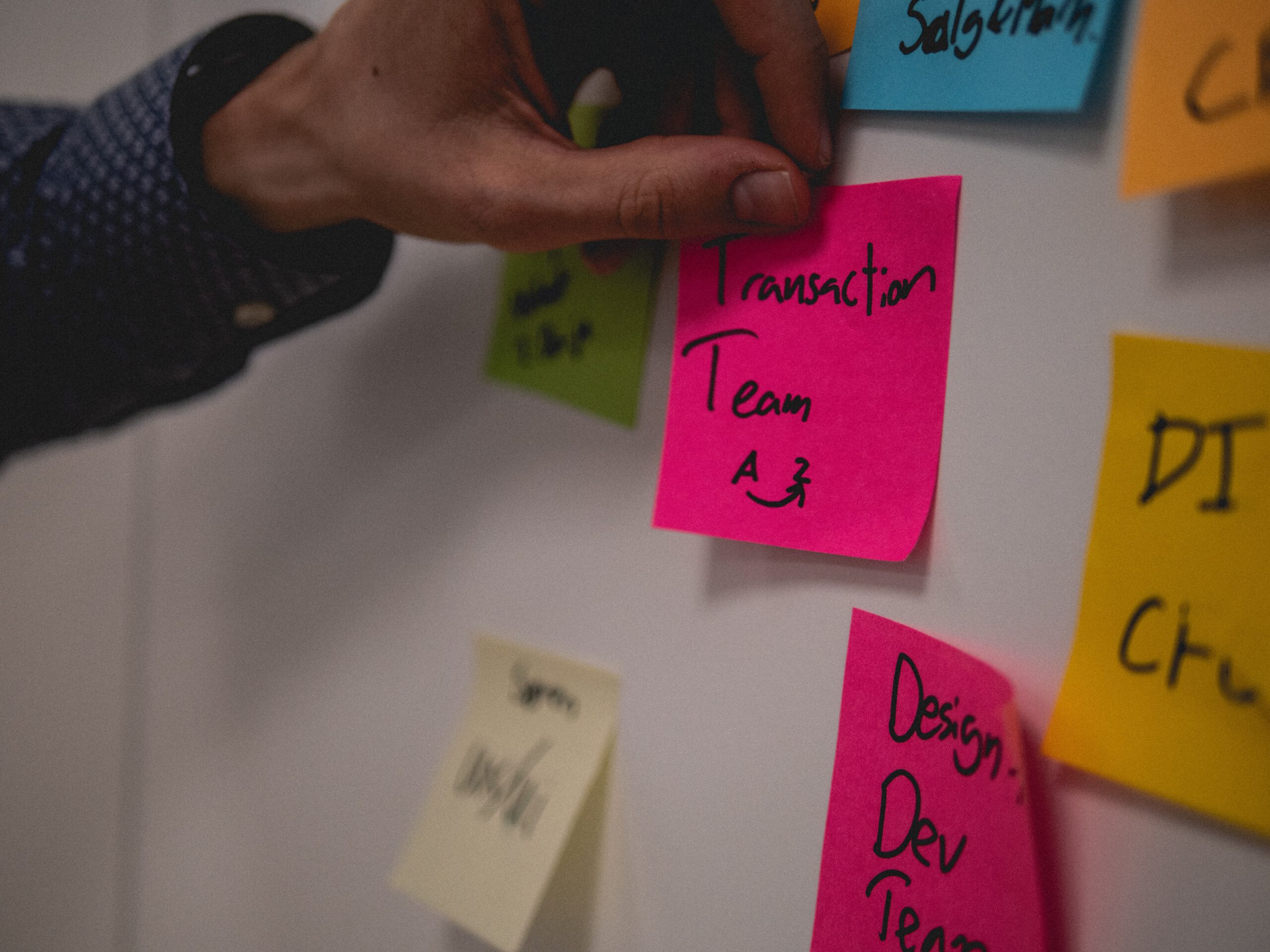Sometimes I’m being asked about my most important tools for my work. Let‘s do some inventory and tool care. First things first: The good old backlog.
Because the first questions to be answered are these important ones: Why do we do exactly what? What matters to us? In THIS project, in THIS product, for us as a business leader, as a company, as a team?
That makes sense.
Because answers to these questions help us decide which investment to pursue. (Especially if we have done our homework: Who does expect what in the matter: us, our customers, our funders, and other stakeholders? In terms of content, financially, strategically? Are the expectations realistic?)
That said, I rarely start with it. Because in my experience, it delays good results. Sometimes it even prevents them.
Therefore, clients are desperate in need of DOING! Their feeling: Something! Must! Happen! Now! (And they are often right about that.)
In other words: They have other worries than that they would or could deal with (in their eyes) somehow important, but momentarily only secondary and non-acute issues.
2. Situational picture/problem description
Backlog entries describe in detail a confusing, tangled situation. And everything that needs to be done in regard to it.

 |
| Photo by the author |
Eine deutsche Version findet sich hier.
Thanks to Simon Sinek’s now famous Ted Talk about the “Golden Circle”, “Start with why!” has been an integral part of every consultant’s repertoire for some years now. At least I was very inspired by it. And I still am.
- WHAT — What do we do? What products and services do we offer? What are they capable of doing or helping?
- HOW — How do we do it? What are our technical and other approaches? What makes us, our product/service different? In which way are we better than the competition?
- WHY — Why do we do it? Why buy from or work with us?
Because the first questions to be answered are these important ones: Why do we do exactly what? What matters to us? In THIS project, in THIS product, for us as a business leader, as a company, as a team?
That makes sense.
Because answers to these questions help us decide which investment to pursue. (Especially if we have done our homework: Who does expect what in the matter: us, our customers, our funders, and other stakeholders? In terms of content, financially, strategically? Are the expectations realistic?)
That said, I rarely start with it. Because in my experience, it delays good results. Sometimes it even prevents them.
When people seek help they have tangible, concrete problems: What to do? How to decide? Do we accept the new order? Should we continue to develop product XYZ, when we have too much to do anyway? Which of the many parallel projects is the most important one?
 |
| Photo by Kvalifik on Unsplash |
Therefore, clients are desperate in need of DOING! Their feeling: Something! Must! Happen! Now! (And they are often right about that.)
In other words: They have other worries than that they would or could deal with (in their eyes) somehow important, but momentarily only secondary and non-acute issues.
Moreover, most of the Clients consider the situation threatening, which narrows their vision and makes them think and act in rigid ways.
In this situation, they have little confidence in their problem-solving abilities and are unable to call on their skills.
They’re in a “stuck state”. They desperately need help. After all, that is why they call a consultant.
A well formulated “Why” and a defined set of their own business values could help clients very practically right now. In this very second.
A well formulated “Why” and a defined set of their own business values could help clients very practically right now. In this very second.
Unfortunately, they are not in a position to recognize that.
Therefore, working on fundamental and central “Why” questions in this situation does not help and might even be harmful. Because great resistance would have to be expected.
Therefore, working on fundamental and central “Why” questions in this situation does not help and might even be harmful. Because great resistance would have to be expected.
So what should we do?
My answer: Take care of the backlog as quickly as possible! If there is none yet, build one! The sooner you start, the better it‘ll be.
But: Why?
1. Signal effect/Security
A sigh of relief. Help! Finally! And even with a plan! Finally, getting things done without any further ado!
A sigh of relief. Help! Finally! And even with a plan! Finally, getting things done without any further ado!
Clients feel understood and taken seriously in their distress - at least that is my guess and hope. This is by no means just a fake. After all, to me also, DOING the right things at the right time is most important when doing business.
“Problem Talking creates Problems…”
2. Situational picture/problem description
Backlog entries describe in detail a confusing, tangled situation. And everything that needs to be done in regard to it.
This helps us getting our bearings: What exactly are we talking about? What is the problem or what are the specific problems? How big are they? Are we talking about projects? Tasks? Dependencies? Structures? About everything at the same time? Which of these are important? How serious? Do we already have ideas about what needs to be done and where?
3. Ability to act
The question of what goes into the backlog and how, the topics and discussions that arise from this — all this is important so that the clients can experience that they are able to act and (of course) able to solve their problems.
The question of what goes into the backlog and how, the topics and discussions that arise from this — all this is important so that the clients can experience that they are able to act and (of course) able to solve their problems.
This is not a magic trick: this way, a large abstract problem becomes visible and manageable in smaller individual packages. A complete solution may not yet be in sight. But at least clients can now see how they can tackle issues one by one.
“…Solution Talking creates Solutions.”
4. Activate solution ability
Instead of a threatening dark forest, clients slowly see trees again in forest sections that can (and must) be managed and taken care of.
Instead of a threatening dark forest, clients slowly see trees again in forest sections that can (and must) be managed and taken care of.
So they broaden their view, feel less and less like victims of the situation, talk less and less about problems, and more and more often about solutions. They trust more and more in their competencies and abilities, they become more flexible, imaginative and creative.
5. Prioritization
The overview of topics, stories, projects, to-dos, etc. (which becomes finer and finer as time goes on) ensures that prioritization can and must take place now. Here, clients usually notice that they don’t have any useful, conscious criteria for this.
The overview of topics, stories, projects, to-dos, etc. (which becomes finer and finer as time goes on) ensures that prioritization can and must take place now. Here, clients usually notice that they don’t have any useful, conscious criteria for this.
This is a good time to talk about what is important and to start working with the Golden Circle: What do we want? What do we need? Why and what for?
This all takes place over some time in several steps and loops. In the course, we keep reviewing the elaborated results. At the same time, the clients reflect on the experience to learn from it together.
Thanks to the backlog with its focus on doing, the clients hardly notice this (important) process. They concentrate on problem-solving and good work results.
Thanks to the backlog with its focus on doing, the clients hardly notice this (important) process. They concentrate on problem-solving and good work results.
That is what they are interested in. That is the most important thing. And that is the consulting mission.
The good old backlog — simply genius!
The good old backlog — simply genius!
Edgars eigener Blog: www.trellisterium.de
Edgars Podcast: trellisterium.podbean.com

Edgar Rodehack ist Teamwork-Enthusiast mit einem Faible für agile Formen der Zusammenarbeit. Da trifft es sich natürlich gut, dass er das beruflich macht. Er ist Organisationsberater, Business und Agile Coach, Teamentwickler und Moderator. Außerdem ist er ein Mensch mit Frau und drei Kindern, der viel Spaß am Musikmachen, Schreiben und Lesen hat. Mehr über ihn: www.rodehack.de
Notes & Links
- Simon Sinek: Start with why - How great leaders inspire action: https://www.youtube.com/watch?v=u4ZoJKF_VuA
- Beiträge zum Thema Backlog auf dem Teamworkblog: https://www.teamworkblog.de/search?q=backlog
- Rodehack, Edgar: Tooling 1: Der gute alte Backlog, Blogpost auf www.teamworkblog.de vom 1.3.2021
- Rodehack, Edgar: Tooling 2: Der gute alte Happiness Index, Blogpost auf www.teamworkblog.de vom 5.4.2021
- Rodehack, Edgar: Tooling 3: Die vier Grundvoraussetzungen für erfolgreiche Veränderung, Blogpost auf www.teamworkblog.de vom 3.5.2021
%20(4).jpg)

Kommentare
Kommentar veröffentlichen